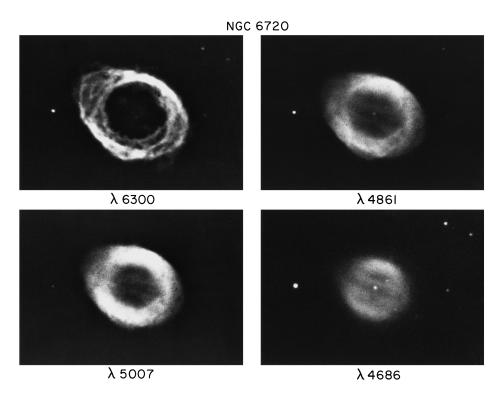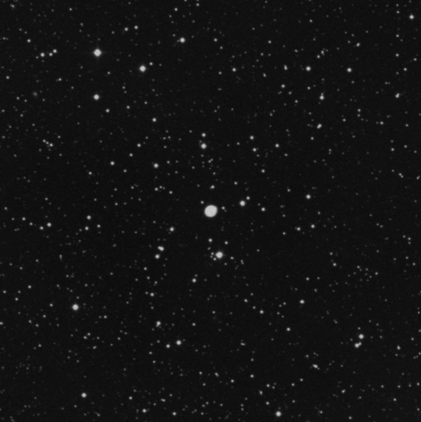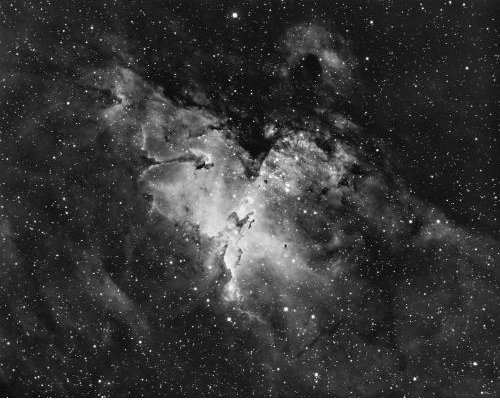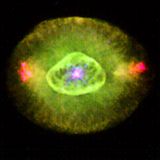
How to find M57, M16, and NGC 6826 using an eye trick this weekend, August 30 - September 1.
Friday, August 30 - Tonight it's time for us to head directly between the two lower stars in the constellations of Lyra and grab the "Ring".
First discovered by French astronomer, Antoine Darquier in 1779, the "Ring" was cataloged later that year by Charles Messier as M57 (Right Ascension: 18:53.6 - Declination: +33:02). In binoculars, the "Ring" will appear as slightly larger than a star, yet it cannot be focused to a sharp point. To a modest telescope at even low power, M57 turns into a glowing donut against a wonderfully stellar backdrop. The average accepted distance to this unusual structure is believed to be around 1,400 light years and how you see the "Ring" on any given night is highly attributable to conditions. As aperture and power increase, so do details and it is not impossible to see braiding in the nebula structure with scopes as small as 8" on a fine night, or to pick up the star caught on the edge in even smaller apertures.

M57 at various wavelengths - Credit: NOAO/AURA/NSF
Like all planetary nebula, seeing the central star is considered the ultimate for viewing. The central itself is a peculiar bluish dwarf which gives off a continuous spectrum and might very well be a variable. At times, this shy, near 15th magnitude star can be seen with ease through a 12.5" telescope, yet be elusive to 31" in aperture weeks later. No matter what details you may see, reach for the "Ring" tonight. Leave a comment if you find it.
Saturday, August 31 - Of course, studying some of the summer's finest astronomical targets means that we'd be very remiss if we didn't look at another cosmic curiosity - "The Blinking Planetary."
Located a couple of degrees east of visible star Theta Cygnii, and in the same lower power field as 16 Cygnii, the NGC 6826 (Right Ascension: 19:44.8 - Declination: +50:31) is often referred to as the "Blinking Planetary" nebula. Viewable in even small telescopes at mid to high power, you'll learn very quickly how it came about its name. When you look directly at it, you can only see the central 9th magnitude star...
Now, look away. Focus your attention on visual double 16 Cygnii. See that? When you avert, the nebula itself is visible. This is actually a trick of the eye. The central portion of our vision is more sensitive to detail and will only see the central star. At the edge of our vision, we are more likely to see dim light, and the planetary nebula appears. Located around 2,000 light years from our solar system, it doesn't matter if the "Blinking Planetary" is a trick of the eye or not... Because it's cool!

NGC 6826 - Credit: Palomar Observatory, courtesy of Caltech
Sunday, September 1 - Don't put away your binoculars tonight just because you think this next study is beyond you? Just lift your sights three degrees higher than the "Omega Nebula" and tonight we'll fly with the "Eagle" - M16 (Right Ascension: 18:18.8 - Declination: -13:47)

M16 - Credit: Bill Schoening/NOAO/AURA/NSF
Small binoculars will have no trouble distinguishing the cluster of stars discovered by Phillipe de Cheseaux in 1746, but larger binoculars and small telescopes from a dark sky site will also see a faint nebulosity to the region that was reported by Charles Messier in 1764. This "faint light" will remind you highly of the reflection that is seen within the Pleiades, or "Rosette" nebula. While the most outstanding views of the "Eagle" nebula are in photographs, larger telescopes will have no problem picking out a vague cloud of nebula, encased stars and an unusual dark obscuration in the center which has always reminded this author of a "Klingon Bird of Prey". While all of this is very grand, what's really interesting is the little notch on the northeast edge of the nebula. This is easily seen under good conditions with scopes as small as 8? and is undeniable in larger aperture. This tiny "notch" rocketed to worldwide fame when viewed through the eyes of the Hubble Space Telescope. Its name? "The Pillars of Creation".
Until next week? Wishing you clear skies and happy observing!
Tammy is a professional astronomy author, President Emeritus of Warren Rupp Observatory and retired Astronomical League Executive Secretary. She has received a vast number of astronomy achievement and observing awards, including the Great Lakes Astronomy Achievement Award, RG Wright Service Award and the first woman astronomer to achieve Comet Hunter's Gold Status.






















